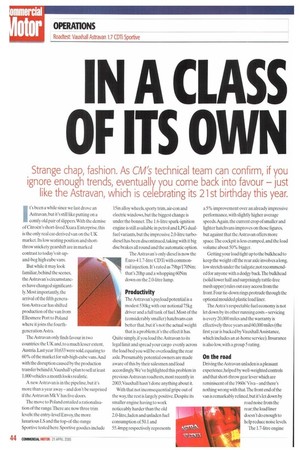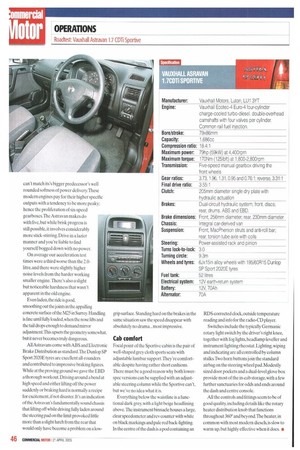N A CLASS OF ITS OWN
Page 44

Page 46

If you've noticed an error in this article please click here to report it so we can fix it.
Strange chap, fashion. As CM'S technical team can confirm, if you ignore enough trends, eventually you come back into favour — just like the Astravan, which is celebrating its 21st birthday this year.
It's been a while since we last drove an Astravan, but it's still like putting on a comfy old pair of slippers, With the demise of Citroen's short-lived Xsara Enterprise, this is the only real car-derived van on the UK market. Its low seating position and shortthrow snickety gearshift are in marked contrast to today's sit-upand-beg high cube vans.
But while it may look familiar, behind the scenes. the Astravan's circumstances have changed significantly. Most importantly, the arrival of the fifth generationAstra car has shifted production of the van from Ellesmere Port to Poland where it joins the fourthgeneration Astra.
The Astravan only finds favour in two countries: the UK and.to a much lesser extent, Austria. Last year 10,633 were sold, equating to 60% of the market for sub-high-cube vans. And with the disruption caused by the production transfer behind it,Vawthall's plan to sell at least 1,000 vehicles a month looks realistic.
A new Astravan is in the pipeline, but ifs more than a year away — and don't be surprised if the Astravan Mk V has five doors.
The move to Poland entailed a rationalisation of the range.There are now three trim levels:the entry-level Envoy, the more luxurious LS and the top-of-the-range Sportive tested here. Sportive goodies include 15in alloy wheels. sporty trim, air-con and electric windows, but the biggest change is under the bonnet. The 1.6-litre spark-ignition engine is still available in petrol and LPG dualfuel variants, but the impressive 2.0-litre turbodiesel has been discontinued, taking with it big disc brakes all round and the automatic option.
The Astravan's only diesel is now the Euro-4 1.7-litre CDTi with commonrail injection. It's rated as 79hp/170Nm; that's 20hp and a whopping 60Nm down on the 2.0-litre lump.
Productivity
The Astravan's payload potential is a modest 530kg with our notional 75kg driver and a full tank of fuel. Most of the (considerably smaller) hatchvans can better that, but it's not the actual weight that is a problem; it's the effect it has. Quite simply, if you load the Astravan to its legal limit and spread your cargo evenly across the load bed you will be overloading the rear axle. Presumably potential owners are made aware of this by their salesmen and load accordingly. We've highlighted this problem in previous Astravan roadtests, most recently in 2003; Vauxhall hasn't done anything about it.
With that not inconsequential gripe out of the way, the rest is largely positive. Despite its smaller engine having to work noticeably harder than the old 2.0-litre, laden and unladen fuel consumption of 50.1 and 55.4mpg respectively represents a 5% improvement over an already impressive performance, with slightly higher average speeds. Again, the current crop of smaller and lighter hatchvans improves on those figures, but against that the Astravan offers more space. The cockpit is less cramped, and the load volume about 50% bigger.
Getting your load tight up to the bulkhead to keep the weight off the rear axle involves a long, low stretch under the tailgate;not recommended for anyone with a dodgy back.The bulkhead (solid lower half and surprisingly rattle-free mesh upper) rules out easy access from the front. Four tie-down rings protrude through the optional moulded plastic load liner.
The Astra's respectable fuel economy is not let down by its other running costs — servicing is every 20,000 miles and the warranty is effectively three years and 60,000 miles (the first year is backed by Vauxhall Assistance, which includes an at-home service). Insurance is also low, with a group 5 rating.
On the road
Driving the Astravan unladen is a pleasant experience, helped by well-weighted controls and that short-throw gear lever which are reminiscent of the 1960s'Viva— and there's nothing wrong with that.The front end of the van is remarkably refined,but it's let down by road noise from the rear; the load liner doesn't do enough to help reduce noise levels.
The 1.7-litre engine can't match its's bigger predecessor's well rounded softness of power delivery.These modem engines pay for their higher specific outputs with a tendency to be more peaky: hence the proliferation of six-speed gearboxes.The Astravan makes do with five, but while brisk progress is still possible, it involves considerably more stick-stirring. Drive in a lazier manner and you're liable to find yourself bogged down with no power.
On average our acceleration test times were a third worse than the 2.0litre, and there were slightly higher noise levels from the harder working smaller engine. There's also a slight but noticeable harshness that wasn't apparent in the old engine.
Even laden,the ride is good, smoothing out the joints in the appalling concrete surface of the M25 in Surrey. Handling is fine until fully loaded, when the nose lifts and the tail drops enough to demand mirror adjustment.This upsets the geometry somewhat. but it never becomes truly dangerous.
AllAstravans come with ABS and Electronic Brake Distribution as standard.The Dunlop SP Sport 2020E tyres are excellent all-rounders and contributed to impressive braking figures. While at the proving ground we gave the EBD a thorough workout. Driving around a bend at high speed and either lifting off the power suddenly or braking hard is normally a recipe for excitement,if not disaster. It's an indication of the Astravan's fundamentally sound chassis that lifting off while driving fully laden around the steering pad on the limit provoked little more than a slight lurch from the rear that would only have become a problem on a low grip surface. Standing hard on the brakes in the same situation saw the speed disappear with absolutely no drama... most impressive.
Cab comfort Focal point of the Sportive cabin is the pair of well-shaped grey cloth sports seats with adjustable lumbar support. They're comfortable despite having rather short cushions. There must be a good reason why both lowerspec versions can be supplied with an adjustable steering column while the Sportive can't, but we've no idea what it is.
Everything below the waistline is a functional dark grey, with a light beige headlining above. The instrument binnacle houses a large, clear speedometer and rev counter with white on black markings and pale red back-lighting. In the centre of the dash is a pod containing an RDS-corrected clock, outside temperature reading and info for the radio-CD player.
Switches include the typically Germanic rotary light switch by the driver's right knee, together with fog lights, headlamp leveller and instrument lighting rheostat. Lighting, wiping and indicating are all controlled by column stalks.Two horn buttons join the standard airbag on the steering wheel pad. Modestly sized door pockets and a dual-level glove box provide most of the in-cab storage, with a few further sanctuaries for odds and ends around the dash and centre console.
All the controls and fittings seem to be of good quality, including details like the rotary heater distribution knob that functions throughout 360° and beyond.The heater, in common with most modem diesels, is slow to warm up, but highly effective when it does. •










































































































































































































